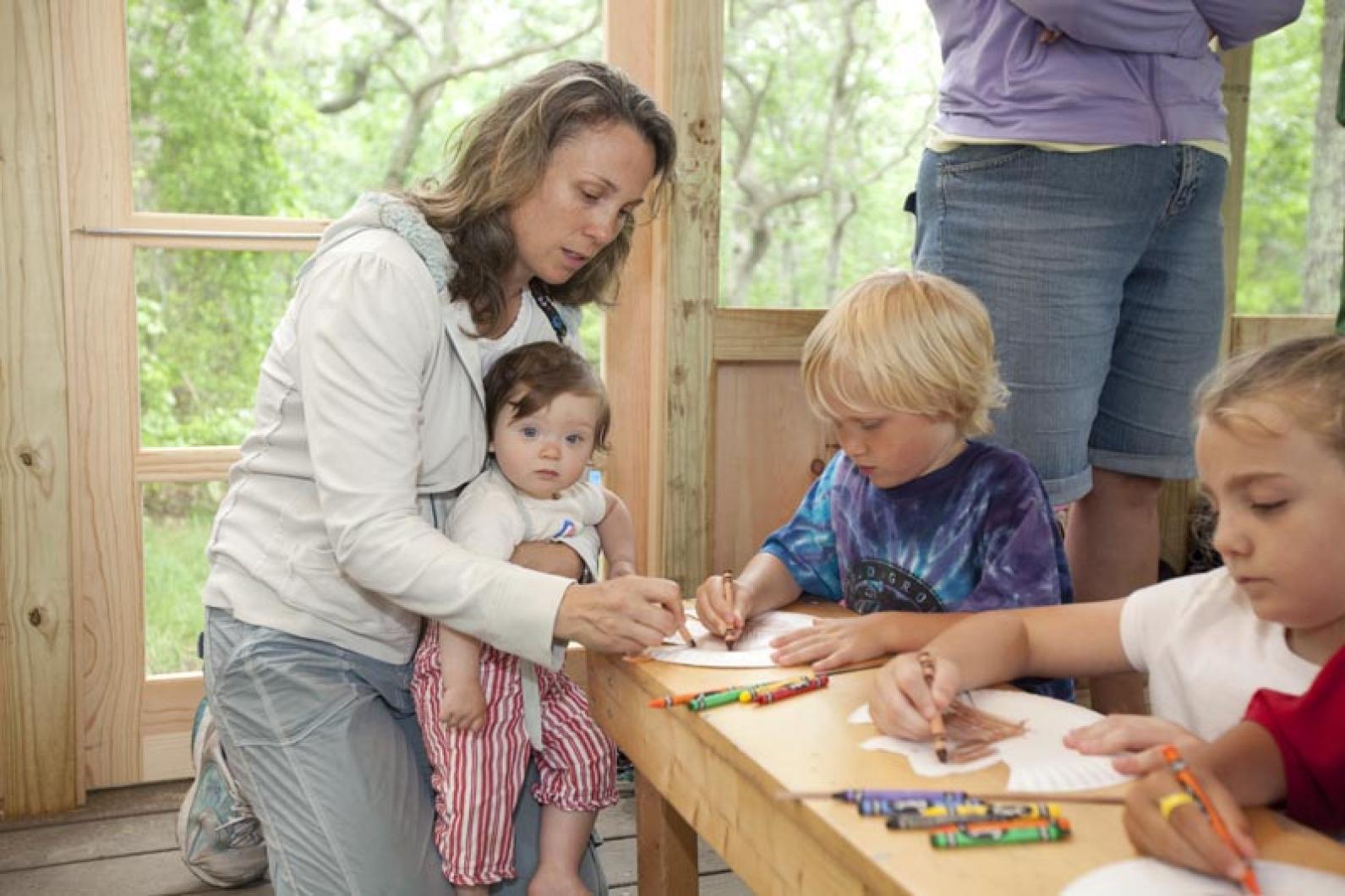It was spider crabs that drew them together.
A circle of children, parents lingering at the back, gathered recently at a new screened-in space at Felix Neck Wildlife Sanctuary, the Vineyard’s MassAudubon center on Sengekontacket Pond, ready for the day’s Creature Feature.
Creature Feature is a program for kids aged three to seven, and today it was Gretchen Tisch’s job to tell them everything they ever wanted to know about spider crabs, a creature whose two names separately can strike fear in the imagination.
Yet the children jumped to their feet enthusiastically as Ms. Tisch began reciting a poem about a spider crab named Sally. They gleefully imitated her motions for a crab, spider, pear and cape while listening intently to the unique characteristics of spider crabs.
Ms. Tisch proved spider crabs are quite fascinating and fun creatures, for numerous reasons. One is their 10 elongated, spider-like legs, which spring out from their spiked shells to crawl slowly and gently from one place to the next. Another is their outer shell, used as a natural camouflage and primary shield to conceal themselves from aquatic predators. Naturally, they have a distinct pear shape and differ in size according to gender.
To demonstrate the difference between the genders, Ms. Tisch took out two different specimens of spider crabs from separated plastic cups filled with water. She explained the way to tell is by looking at the abdomen. “The female has a rounded triangle. The male has a pointier, skinnier abdomen,” she said.
As she held the spider crabs in both hands, some children gravitated toward her, thrilled to see the living creatures and interact with them, while others returned toward parents for shelter from the sea crawlers. Ms. Tisch peered into the crowd of kids gazing at the crabs: “Who thinks they wanna hold one?
“They’re very nice. They don’t hurt,” she reassured the children.
Ms. Tisch took around the male spider crab first, and boys and girls cheerily anticipated the tickling sensation from the crab’s multiple legs gingerly walking across their hands. Some shy children even dared to touch the spider crab, after looking to parents and Ms. Tisch for reassurance. Others laughed and gained a new sense of accomplishment and bravery, while others waited until their parents allowed the spider crab to crawl on them first.
Next came the female spider crab. Ms. Tisch educated the children some more, highlighting interesting details about their body structure, such as the different shaped mouths of the female and male crabs. She also informed the kids about the spider crabs’ natural habitat in the ocean and areas such as Sengekontacket Pond, where Ms. Tisch found these particular specimens. Again, the children gathered around to touch the spider crabs before the group leader steered their attention toward arts and crafts.
The children constructed their very own personalized spider crabs made out of colorful container lids, pipe cleaners, glue, paper and beads. “Camouflage it from your favorite place,” Ms. Tisch said, citing multiple places they could use for inspiration, such as their bedroom or the ocean. Parents and babysitters helped kids create original, artistic renditions of spider crabs. Some kids who were still puzzled and not quite sure how they should go about constructing their spider crab turned to Ms. Tisch for advice. She jubilantly asked, “What do spider legs look like?” and, “You can bend them however you want so they look like a spider crab.”
So they twisted and beaded, and added glitter glue and green crinkled paper representing seaweed as their parents took photos. The result was a crafty keepsake of their excursion to Felix Neck.
Ms. Tisch, an art education major, said, “I love the art part.”
Young participants Ryan and Ben Standaert agreed they had learned a lot about spider crabs. Ryan said, “I kind of learned that you can tell the difference between them by their abdomens.” Ben added, “I didn’t know they were shaped like a pear.”
Liza Opel-Omia said her favorite part was, “making the crabs . . . touching them and also holding them.”
Tiffany Johnson, babysitter of seven-year-old Jackson Pachico, noted that she believed she was too old to participate in the event, but was excited to be back at Felix Neck: “I went a bunch when I was a kid.”
Ms. Tisch said parents often participate: “They get involved, encouraging their children ... some are already coming tomorrow.” Lynn Martinka, a parent, said the kids generally gravitate toward “anything hands-on.”
Liz Thorn, another parent, who has returned to Felix Neck year after year, reported to the Gazette, “We always love to come. They learn things as well as have fun making things. It’s great when. they go to the beach — they feel like experts,” she said
Creature Feature programs are at Felix Neck most Tuesday and Wednesday mornings from 10:30 to 11:30 a.m. See the Vineyard Living listings in the Gazette for the creature of the day.







Comments
Comment policy »